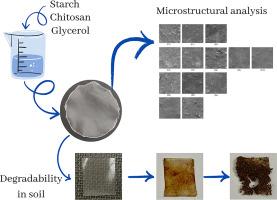壳聚糖对淀粉膜的影响:土壤理化性质和可降解性分析
引用次数: 0
摘要
目的是评价壳聚糖对膜的性能和可降解性的影响。用铸造法显影,得到10个测定值(E1 ~ E10)。影片E1和E3表现出优异的视觉特性。不透明度为3.92 ~ 6.42 1/mm,透光率为18% ~ 31%。E4薄膜较厚,证明其耐蚀性更强,溶解性更低,约为45%。在吸水性方面,所有膜在前72 h表现出相同的吸水性,144 h后,E6膜在相对湿度(RH)分别为75%和85%时吸水性更强。在阻隔性能方面,薄膜的水蒸气渗透性(WVP)在0.30 ~ 1.47 g mm/m2 h kPa之间。在生物降解性方面,7天后,所有薄膜都吸收了水分,变得具有延展性和柔韧性。35 d后,膜的质量损失较大,其中E2的质量损失最小(27%),E6的质量损失最大(40%)。67天后,膜降解。综上所述,壳聚糖改善了E1膜的均匀性、连续性和处理性,具有低溶解度、低透气性和可生物降解性。本文章由计算机程序翻译,如有差异,请以英文原文为准。

Impact of incorporating chitosan into starch films: analysis of physicochemical properties and degradability in soil
The aim was to evaluate the effect of incorporating chitosan in films in relation to their characteristics and degradability. The films were developed by the casting method obtaining ten assays (E1 to E10). Films E1 and E3 showed excellent visual characteristics. Opacity was between 3.92 and 6.42 1/mm, while transmittance ranged from 18 to 31 %. The E4 film was thicker, proving to be more resistant and less soluble, around 45 %. Regarding water absorption, all films showed the same absorption behavior in the first 72 h. After 144 h, the E6 film absorbed more water, for relative humidity (RH) of 75 and 85 %, respectively. In the case of the barrier property, the films presented water vapor permeability (WVP) between 0.30 and 1.47 g mm/m2 h kPa. Regarding biodegradability, after 7 days, all films had absorbed water, becoming malleable and flexible. Then, after 35 days, the films showed high mass loss, where E2 had the lowest mass loss (27 %) and E6 the highest (40 %). After 67 days, the films were degraded. Based on the above, it was concluded that chitosan improved the homogeneity, continuity, and handling of the E1 film, providing low solubility and permeability to water vapor, and being biodegradable.
求助全文
通过发布文献求助,成功后即可免费获取论文全文。
去求助
来源期刊

Food chemistry advances
Analytical Chemistry, Organic Chemistry, Chemistry (General), Molecular Biology
CiteScore
1.90
自引率
0.00%
发文量
0
审稿时长
99 days
 求助内容:
求助内容: 应助结果提醒方式:
应助结果提醒方式:


